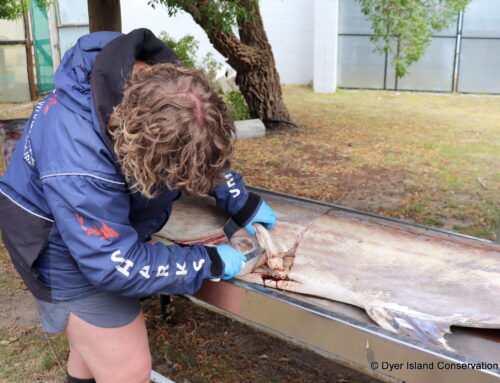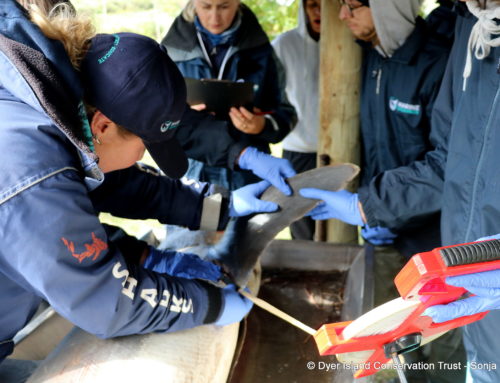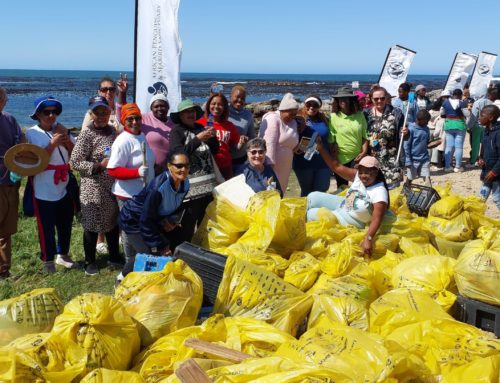Approval granted
February 18, 2010 by dyertrust
by DICTs Marine Biologist Alison Towner
Progress with UCT! After an official letter of acceptance from the department of Zoology at UCT I was finally able to register. After waiting for so long for this opportunity I think its safe to say I was the happiest second time student in Africa- if not the world! To add to the great news the department of Avian demography reimbursed me a fee based on the work the DICT has supported over the years- which has helped enormously. All is looking good!
I would just like to say a huge big thanks to all who have supported and donated so far. The amount of conservation and pro shark protection people we get on our cage diving boat actually restores all my faith in humanity and to date we have now received over 400 donations- (all from shark cage clients!). This means in our tagging kitty we have now R60,000 to buy equipment to follow the sharks with.
We are hoping to begin our first tracks towards the end of March, by which time hopefully the MCM research permit will be issued by Marine and Coastal Management.
In conjunction with the white shark project Meaghan McCord is now back in the Breede river based on other species of sharks in the Western Capethe Zambezi or Bull shark. The first expedition was funded by MD cage diving clients last year. On the first study Meaghan and her co workers at SASC managed to land, tag and track the world biggest Zambezi shark- a four meter female. This year we can confirm she has two more male animals bleeping away with transmitters on their dorsals in the system and the success of the project continues to rise. Marine Dynamics guests can feel good about this! Meaghan will be helping out with our white shark research program too and her tracking expertise will be welcomed.
January shark sightings
We have had the perfect start to the New Year. The sharks have been great the water warm, and our guests extremely satisfied with their sightings. The most repeated sentence spoken between the Marine Dynamics crew on board Shark Fever has been This cannot be January!
The month started off with repeated winter bouts of weather every few days- very similar to last month. These westerly wind intervals continued the whole way through January and kept our water temperature between 15 and 18 degrees Celsius (only dipping as low as 13.2 on two occasions). This is seriously tropical conditions for Gansbaai that can get as low as 9 Celsius at this time! Visibility has also been relatively good clocking up to 5m on a few occasions during the last week of the month.
And so shark activity has been stunning! Still (touch wood) we have not yet had a miss trip/ no show so far. On average we have been sighting 4-7 sharks a trip, notably the activity levels of the sharks have been super high. In particular we seemed to pick up certain sharks that would stay around and interact with us for the whole trip. Combined with this there has been a real abundance of sharks around. One of the major assumptions about the summer inshore area for white sharks is that there are generally very few males and around 90% are females and juveniles.
However, it seems this January we have encountered more than 40-50% males usually sub adults which leads us back to the two questions of why and what is different?
Famous and familiar fins
Our celeb shark of the month has been a 2.9m female we named Ilze after a good fried of ours who is a South African tour guide and joins us on the boat regularly. This shark has a fantastic nature and inquisitively approaches our cage very closely. We have also reached the conclusion that she simply loves our boat as we encountered her everyday non stop for over a two week time period! Another great shark in the area is a male we know as Jagger. His extremely distinctive dorsal fin got him the name and we recognise his dorsal but cannot place it with our database. The shark is encrusted with copepods (parasites) by the posterior of his body and his dorsal. Often sharks arrive in Gansbaai fouled with copepods and they fall off during their stay. We get the impression that Jagger has been away from Gansbaai for a while and only just returned. He is a very bold shark in nature and quite greedy too!
Another small male named Micky has the most remarkable beauty spots on his dorsal and tail. These white marks are often useful with identification and are referred to as rosies. It is believed that they may resemble something similar to a human birth mark. Micky has huge star shaped rosies on both left and right sides of his dorsal.
Two familiar fins this month are Prop and Speedy. Prop is a small 2.3m male- with the tiniest claspers (male genitals on a shark)- which we only discovered this month- and he is our case study shark on wound healing study. Speedy arrived in and left Gansbaai very quickly but there was no mistaking her unique character and appearance. Firstly, shes big around 3.5m. Secondly, shes feisty and has the tip of her tail missing. Her name describes her perfectly.
Other marine life- cetaceans and birds
Finally our Southern right whales have moved off. The whale season was a nice long one with quite a few loose groups of whales still hanging around the Western Cape hotspots well into early January. Now it is believed they migrate off to the Antarctic waters to indulge on krill (zoo plankton rich in protein). Towards the end of the month our company director, Wilfred Chivell, decided to run a pelagic excursion on the Whale Whisperer. We took the boat out 20-25km behind dyer island into the open ocean where the depth is over 80m. It was a stunning morning with perfect sea conditions. The four hour trip allowed us to observe huge Brydes whales go about their thing quietly in the blue. On our return journey we were fortunate to observe a complete bird frenzy with literally thousands of Cape Cormorant and every other species gathering busily to feed on fish. Accompanying the cormorants were thousands of Cape gannets which dived spectacularly from the sky into the water in pursuit of their meal. Amazing to watch!
Seals
On the odd ventures up to Dyer Island that we made this month it was clear to see their time is coming if only they knew!. The Cape fur seal pups are swarming the shores of Geyser Rock- eagerly dipping their flippers into the water and learning the manoeuvres of how to swim and survive. Interestingly with the westerly winds intervening there have already been a few white sharks sighted and worked with at the Island.
IWSS International White Shark symposium
The International White Shark Symposium is being held next month from the 7-10th of February. Both Hennie Otto (Marine Dynamics shark boat skipper) and I will be attending. We look forward to getting the latest information on the most up to date white shark research conducted by the worlds best in the field. South African researcher Alison Kock of Save Our Seas will be one of the symposium directors and will undoubtedly do South Africa proud by discussing all the hard work she has been doing with False Bays whites. I will be presenting my very first scientific poster on the wound healing of great whites and Im really excited about the whole event. Not to mention, the location happens to be in the exotic island of Hawaii! We shall keep you updated on the symposium in next months newsletter.




